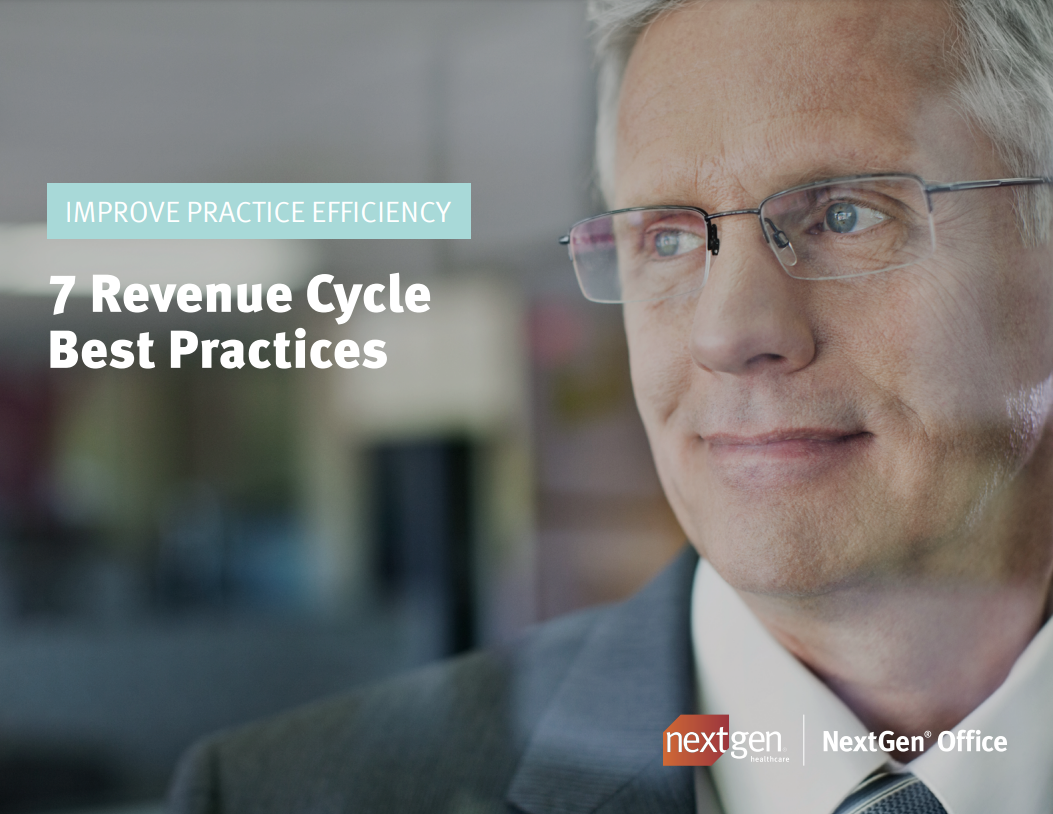Revenue Cycle Management Best Practices Webinar
Whether you use Medisoft, Lytec or Practice Partner, every practice’s Revenue Cycle Management is the same. It starts when a patient sets an...
6 min read
AVS Medical : Oct 2, 2023 10:44:45 AM

Now more than ever—consider a new approach to your revenue cycle
Effective revenue cycle management has become more critical for ambulatory medical practices because of the COVID-19 public health emergency. According to a survey from the Medical Group Management Association, 97% of medical practices experienced financial harm as a result of COVID-19. Fifty-five percent said revenue is down since the start of the crisis and 60% said patient volume is down. Under such circumstances, practices need to
be even more mindful of implementing the correct procedures for billing and practice management.Medical practices need to consider both where they stand today and how they can best plan for the future. You can improve both your current situation and the long-term outlook with a focus on the right revenue cycle tactics and solutions.
Below is our list of 7 things you can do to improve your practice efficiency and better manage your revenue.
1. Self-Pay Collections
Check eligibility to get more money, faster. About 60% of Americans are insured through their employers. To cut costs, these employers are passing fees on to employees through increased copays, deductibles, coinsurances, and decreasing overall benefit coverage.
With patient deductibles and coinsurance increasing each year, patient collections can make or break the financial health of a practice. It all starts with checking a patient’s eligibility. With a user-friendly tool, you can verify a patient’s eligibility, plan specifics, and copays/deductibles.
It's important to check eligibility to:
• Obtain up-front collection of copays and deductibles
• Eliminate claim denials, claim resubmittals, and unpaid patient balances in accounts receivable (AR)
Execute self-pay best practices
• Check if patient does/does not have insurance
• Obtain accurate patient demographics data
• Provide front-end staff with training (and ample scripting) to increase comfort with point-of-service collections
Implement creative ways to collect patient payments:
• Kiosk technology
• Patient portal
• Electronic statements
• Service refusal (to patients who owe money)
2. Performance Measurement
Leverage AR transparency
Monitoring your revenue cycle allows you to compare key billing indicators from month to month and year to year. You can then measure your practice against industry and specialty standards.
Analysis of key performance indicators can help you find opportunities to improve business efficiency and uncover problems with payers. We recommend establishing metrics that can be reviewed on a consistent basis, at minimum, every 30 days. By analyzing these metrics you’ll see a clearer picture of how fast you are getting paid, who’s not paying, and why. With that knowledge, you're can improve processes to ensure a healthy AR.
Key RCM indicators can help you benchmark and achieve best-practice objectives:
• Monthly charges, payments, and adjustments compared to averages and historical data
• Charge-entry lag times
• Denial percentage
• Clean-claim-rate percentage
• AR aging by date of service
• Gross-collection percentage
• Net-collection percentage
• Days in AR
3. Claims Scrubbing
Use best practices for cleaner claims and appeals Even experienced billers can miss errors when reviewing claims manually. Implementing claim-scrubbing software, which identifies
and fixes problem claims automatically, can save billers time, ensure greater accuracy, and
generate faster error resolution.
Another best practice is to monitor the workflow to ensure protocols are followed and errors are resolved in a timely manner. A good claim-scrubbing system can significantly reduce denials. That means accelerated and increased revenue for you.
Be sure to appeal denied claims. According to the Medical Group Management Association (MGMA), only 35% of providers do. Inspect your denied claims, ensure they are correct, and develop a denial-management process in your practice.
Best practices
• Use claims-scrubbing technology to reduce rejections and denials
• Create a library of system edits to improve first-pass claims success
• Load CCI edits—appropriate CPT and diagnosis combinations
• Use advanced scrubbing with a payer rules engine specifying codes and modifiers for each payer
• Ensure EHRs are integrated with billing
• Ensure all payer-required fields are completed
• Leverage online reporting and analytics reporting
• Contract compliance software that catches and corrects frequent payer underpayments
4. Track and Prevent Denials
Capture, analyze, and act on denial data Effective denials management is about being proactive and diligent. Engaging in eligibility verification prior to a patient’s visit is one front-end strategy to reduce denials. On the back end, develop a routine system for denials monitoring. Typically, 85 to 95% of claims are either paid on the first pass or prompt an action to redirect the collection to a secondary payer or the patient. The remaining 5 to 15% of claims present an opportunity to improve the revenue cycle.
It is important to regularly review which carriers, CPTs, reasons, and processes are driving your denials. It’s also important to identify areas where your RCM staff may be performing redundant tasks. Review real examples of denial analysis and interventions to understand the types of edits and approaches that will help you build an experience library. This library can be used to learn from your denials and prevent them from happening again.
Denials management is not a one-and-done effort. It must be ingrained
in daily, weekly, and monthly workflow. The goal is to eliminate the
root cause of denials through improved workflow and technology,
resulting in optimized revenue and minimized re-work. Additional
recommendations for tracking and preventing denials:
• Create a mechanism to trap denials from all sources of remits, including 835 files and manual remits
• Organize denials into categories, such as:
• Eligibility
• Coding
• Non-covered services
• Authorization/Referrals
• Analyze patterns and create alternative workflows to reduce denials
• Consider bulk eligibility verification
5. Create and Enforce Write-Off Policies
Employ the right approach to write-offs Sound policies and procedures for write-offs are essential to running an efficient practice. Some medical practices have a formal manual to help ensure they take advantage of all available ways to increase their bottom line. To avoid unintentionally providing free services and leaving money on the table, practices need proactive financial policies. The policies should be consistently enforced and, when appropriate, shared with patients.
Contractual write-off: part of a patient’s bill that can’t be charged due to payer agreements, including:
• Charity write-offs (the difference between the practice fee schedule and what’s collected) may be in accordance with an indigent care effort, a policy adhered to in a faith-led healthcare system, or a financial assistance program
• Small balance write-offs (the amounts left on the patient’s account that may not warrant the cost of sending a bill) which have been estimated to cost about $12 each
• Prompt payment discounts and self-pay (no insurance) discounts are write-offs for patients paying in full at the time of service, or discounts given to patients without coverage
Necessary or approved write-off: write-offs that you have agreed to, either in the context of a contract, or in terms of your practice philosophy
Unnecessary write-offs: write-offs that, more often than not, can be avoided with timely filing of appeals. They are a result of billing mistakes or situations that you should have been able to control, including:
• Timely filing write-offs caused by filing the claim past the date required by the payer
• Uncredentialed provider write-offs are those caused by filing a claim for a provider before they are credentialed with the payer
• Administrative write-offs are those approved by the practice based on service issues or practice error
• Bad-debt write-offs are balances that you have decided to write off and not pursue further
Collection agency write-offs: balances not forgiven but written off the main AR and transferred to a third-party collection agency to collect on your behalf.
6. Remind Patients Of Appointments
Use appointment reminders to boost AR
Ensuring as many appointment slots as possible are filled and patients are confirmed is critical to financial well-being. Appointment no-shows impact your bottom line with staff-time costs but can be reduced with an automated appointment confirmation system. HIPAA considers appointment reminders as part of treatment. They can be made without an authorization, but require you to do what you can to accommodate a patient’s preferred method of communication. You can remind patients by mail, email, text, and/or phone.
In most practice management (PM) systems, this is an easy task. Most dialing systems can accept your appointment schedule from existing reports already contained in your PM system.
NextGen Office allows you to view your appointment schedule from your NextGen® Practice
Management system on your laptop, iPad, or mobile device. It sends automated appointment
reminders to your patients via text and/or email so they can confirm their appointments
from their device.
Monitor for success
Track your cancellations and no-shows to find where improvements can be made to increase
your kept appointments rate. Adjust parameters such as how far in advance your patients are contacted to see what works best.
Final recommendations:
• If not already in place, implement a policy for no-show and/or late cancellation charges to attempt to recoup lost revenue
• Utilizing staff time for patient reminders is inefficient and costly. Look to increase staff productivity while decreasing cost by implementing a third-party appointment-reminder product
• At minimum, the patient should validate:
• Date and time
• Location
• Copay amount
7. Maximize Electronic Remittance Advice
Make the most of electronic remittance advices
To expedite cash flow and correct payment posting mistakes, sign up for electronic remittance advices (ERAs). Electronic claim submission maximizes the efficiency of claims processing. Paper submissions do not. About 99% of payers accept electronic claims and Medicare requires them. It takes an average of two weeks to receive reimbursement for
an electronic claim if you establish an ERA, and six to eight weeks for a paper one. According to the American Medical Association (AMA), the average cost of processing a clean paper claim is $6.63. The same claim sent electronically costs only $2.90.
Electronic claims help optimize revenue cycles by streamlining the billing process and reducing paperwork. With electronic remittance, your clean claim rates and turnaround times will improve, ensuring you’re paid faster.
By implementing automated PM tools and setting up auto-posting of your remittance information back into your billing system, you can reduce or eliminate many time-consuming routine tasks. This frees your staff to handle other assignments or to focus more on care.
Best practices
• Set the background business processor to:
• Bill encounters nightly
• Create your EDI files nightly
• Print paper claims daily or have your claim clearinghouse print HCFAs
• Create your statement file as needed: weekly, monthly, or daily
For unique claim situations, make sure you are using the claim print libraries.
Nextgen Office has published an E-book that provides greater detail about these recommended practices. Download the full E-book Here!

Whether you use Medisoft, Lytec or Practice Partner, every practice’s Revenue Cycle Management is the same. It starts when a patient sets an...

A medical practice’s cash flow is an important gauge of its overall financial health, but there are additional metrics that will highlight areas of...

In today’s challenging healthcare environment, independent practices are under increasing pressure. The rising cost of running a practice—driven by...